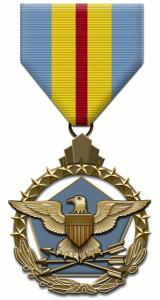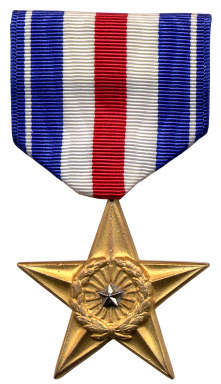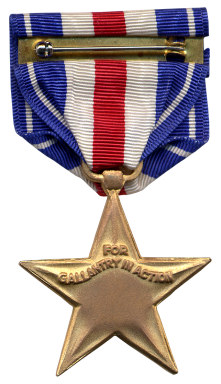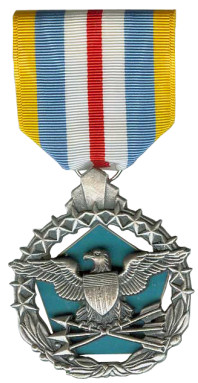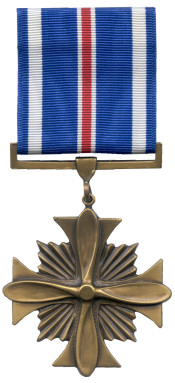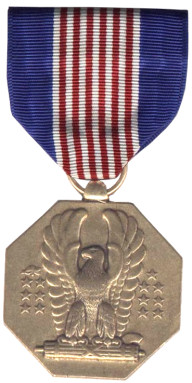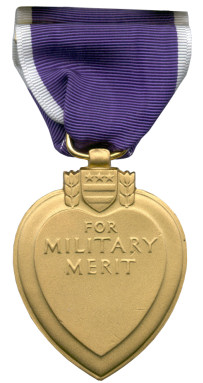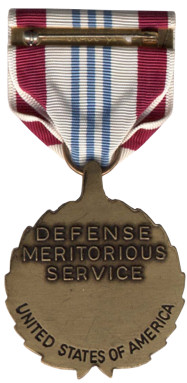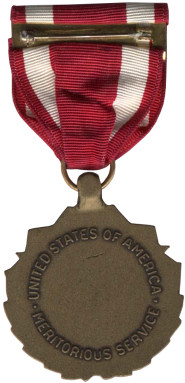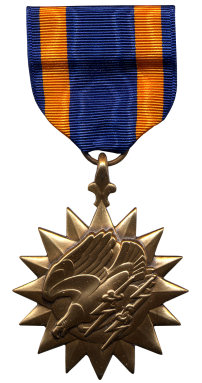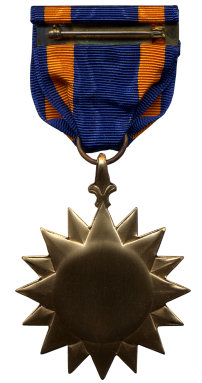MEDAL OF HONOR
UNITED STATES ARMY
Description: A gold five pointed star, each point tipped with trefoils, 1 ½ inches wide, surrounded by a green laurel wreath and suspended from a gold bar inscribed "VALOR", surmounted by an eagle. In the center of the star, Minerva’s head surrounded by the words "UNITED STATES OF AMERICA." On each ray of the star is a green oak leaf. On the reverse is a bar engraved "THE CONGRESS TO" with a space for engraving the name of the recipient.
Medal of Honor Ribbon
Ribbon: The medal is suspended by a neck ribbon, 1 3/8 inches wide, Bluebird 67117. A shield of the same color ribbon with thirteen White (67101) stars, arranged in the form of three chevrons is above the medal. The service ribbon is 1/38 inches wide with five White stars in the form of a "M".
Criteria: The Medal of Honor is awarded by the President, in the name of Congress, to a person who, while a member of the Army, distinguishes himself or herself conspicuously by gallantry and intrepidity at the risk of his or her life above and beyond the call of duty while engaged in action against an enemy of the United States; while engaged in military operations involving conflict with an opposing foreign force; or while serving with friendly foreign forces engaged in an armed conflict against an opposing armed force in which the United States is not a belligerent party. The deed performed must have been one of personal bravery or self-sacrifice so conspicuous as to clearly distinguish the individual above his or her comrades and must have involved risk of life. Incontestable proof of the performance of the service will be exacted and each recommendation for the award of this decoration will be considered on the standard of extraordinary merit.
Background:
a. General George Washington had created the Badge of Military Merit on 7 August 1792 but it had fallen into disuse after the Revolutionary War. Decorations, as such, were still too closely related to European royalty to be of concern to the American people. However, the fierce fighting and deeds of valor during the Civil War brought into focus the realization that such valor must be recognized. Legislation was introduced in the Senate on 17 February 1862, which authorized the medal for the Army and followed the pattern of a similar award approved for Naval personnel in December 1861. The Resolution provided that: "The President of the United States be, and he is hereby, authorized to cause two thousand "medals of honor" to be prepared with suitable emblematic devices, and to direct that the same be presented, in the name of Congress, to such noncommissioned officers and privates as shall most distinguish themselves by their gallantry in action, and other soldier-like qualities during the present insurrection, and the sum of ten thousand dollars be, and the same is hereby appropriated out of any money in the Treasury not otherwise appropriated, for the purpose of carrying this resolution into effect."
b. The original design for the Army was created by Christian Schussel and engraved by Anthony C. Pacquot. The pendant was identical to the design approved by the Navy, with the exception of the suspension and clasp. It consisted of a five-pointed star, tipped with trefoils containing a crown of laurel and oak. In the middle, a band of 34 stars represented the number of States in 1862. Minerva, personifying the United States, stands with a left hand resting on fasces and right hand holding a shield blazoned with the United States arms. She repulses Discord, represented by snakes. The pendant was suspended by a trophy of crossed cannons, balls, sword and an American eagle. The clasp was two cornucopias and the arms of the United States.
c. The initial law was amended by an Act of Congress on 3 March 1863 to extend its provisions to include officers.
d. In 1896, misuse of the medal led to a change in the design of the ribbon because the original had been imitated by nonmilitary organizations. This change was authorized by Joint Resolution of Congress, Fifty-Fourth Congress, Sess. I, 2 May 1896. At this time a bowknot (rosette) was adopted to be worn in lieu of the medal. The ribbon and bowknot (rosette), established and prescribed by the President, was promulgated in War Department Orders dated 10 November 1896.
e. On 23 April 1904, Congress authorized a new design of the medal. The design adopted at that time was designed by Major General George L. Gillespie and is the one currently in use. The medal was worn either suspended from the neck or pinned over the left breast in precedence to other military decorations.
f. The present neck ribbon was adopted in 1944. It is worn outside the shirt collar and inside the coat, hanging above all other decorations.
g. Special entitlements for recipients of the Medal of Honor include:
1) Each Medal of Honor awardee may have his name entered on the Medal of Honor Roll (38 USC 560). Each person whose name is placed on the Medal of Honor Roll is certified to the Department of Veterans Affairs as being entitled to receive the special pension of $400 per month.
(2) Enlisted recipients of the Medal of Honor are entitled to a supplemental uniform allowance.
(3) Special entitlements to air transportation under the provisions of DOD Regulation 4515.13-R.
(4) Identification card, commissary and exchange privileges for Medal of Honor recipients and their eligible dependents.
(5) Children of recipients are eligible for admission to the U.S. Service Academies without regard to the quota requirements.
(6) Ten percent increase in retired pay under Title 10, USC 3991, subject to the 75% limit on total retired pay.
UNITED STATES ARMY
Description: A gold five pointed star, each point tipped with trefoils, 1 ½ inches wide, surrounded by a green laurel wreath and suspended from a gold bar inscribed "VALOR", surmounted by an eagle. In the center of the star, Minerva’s head surrounded by the words "UNITED STATES OF AMERICA." On each ray of the star is a green oak leaf. On the reverse is a bar engraved "THE CONGRESS TO" with a space for engraving the name of the recipient.
Medal of Honor Ribbon
Ribbon: The medal is suspended by a neck ribbon, 1 3/8 inches wide, Bluebird 67117. A shield of the same color ribbon with thirteen White (67101) stars, arranged in the form of three chevrons is above the medal. The service ribbon is 1/38 inches wide with five White stars in the form of a "M".
Criteria: The Medal of Honor is awarded by the President, in the name of Congress, to a person who, while a member of the Army, distinguishes himself or herself conspicuously by gallantry and intrepidity at the risk of his or her life above and beyond the call of duty while engaged in action against an enemy of the United States; while engaged in military operations involving conflict with an opposing foreign force; or while serving with friendly foreign forces engaged in an armed conflict against an opposing armed force in which the United States is not a belligerent party. The deed performed must have been one of personal bravery or self-sacrifice so conspicuous as to clearly distinguish the individual above his or her comrades and must have involved risk of life. Incontestable proof of the performance of the service will be exacted and each recommendation for the award of this decoration will be considered on the standard of extraordinary merit.
Background:
a. General George Washington had created the Badge of Military Merit on 7 August 1792 but it had fallen into disuse after the Revolutionary War. Decorations, as such, were still too closely related to European royalty to be of concern to the American people. However, the fierce fighting and deeds of valor during the Civil War brought into focus the realization that such valor must be recognized. Legislation was introduced in the Senate on 17 February 1862, which authorized the medal for the Army and followed the pattern of a similar award approved for Naval personnel in December 1861. The Resolution provided that: "The President of the United States be, and he is hereby, authorized to cause two thousand "medals of honor" to be prepared with suitable emblematic devices, and to direct that the same be presented, in the name of Congress, to such noncommissioned officers and privates as shall most distinguish themselves by their gallantry in action, and other soldier-like qualities during the present insurrection, and the sum of ten thousand dollars be, and the same is hereby appropriated out of any money in the Treasury not otherwise appropriated, for the purpose of carrying this resolution into effect."
b. The original design for the Army was created by Christian Schussel and engraved by Anthony C. Pacquot. The pendant was identical to the design approved by the Navy, with the exception of the suspension and clasp. It consisted of a five-pointed star, tipped with trefoils containing a crown of laurel and oak. In the middle, a band of 34 stars represented the number of States in 1862. Minerva, personifying the United States, stands with a left hand resting on fasces and right hand holding a shield blazoned with the United States arms. She repulses Discord, represented by snakes. The pendant was suspended by a trophy of crossed cannons, balls, sword and an American eagle. The clasp was two cornucopias and the arms of the United States.
c. The initial law was amended by an Act of Congress on 3 March 1863 to extend its provisions to include officers.
d. In 1896, misuse of the medal led to a change in the design of the ribbon because the original had been imitated by nonmilitary organizations. This change was authorized by Joint Resolution of Congress, Fifty-Fourth Congress, Sess. I, 2 May 1896. At this time a bowknot (rosette) was adopted to be worn in lieu of the medal. The ribbon and bowknot (rosette), established and prescribed by the President, was promulgated in War Department Orders dated 10 November 1896.
e. On 23 April 1904, Congress authorized a new design of the medal. The design adopted at that time was designed by Major General George L. Gillespie and is the one currently in use. The medal was worn either suspended from the neck or pinned over the left breast in precedence to other military decorations.
f. The present neck ribbon was adopted in 1944. It is worn outside the shirt collar and inside the coat, hanging above all other decorations.
g. Special entitlements for recipients of the Medal of Honor include:
1) Each Medal of Honor awardee may have his name entered on the Medal of Honor Roll (38 USC 560). Each person whose name is placed on the Medal of Honor Roll is certified to the Department of Veterans Affairs as being entitled to receive the special pension of $400 per month.
(2) Enlisted recipients of the Medal of Honor are entitled to a supplemental uniform allowance.
(3) Special entitlements to air transportation under the provisions of DOD Regulation 4515.13-R.
(4) Identification card, commissary and exchange privileges for Medal of Honor recipients and their eligible dependents.
(5) Children of recipients are eligible for admission to the U.S. Service Academies without regard to the quota requirements.
(6) Ten percent increase in retired pay under Title 10, USC 3991, subject to the 75% limit on total retired pay.




 by memphismeister Sun Aug 23, 2009 7:20 pm
by memphismeister Sun Aug 23, 2009 7:20 pm
